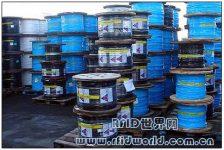
Sada Cavi uses RFID to quickly locate cable loops to reduce material waste
[ad_1]
In order to quickly locate the cable spool in the warehouse, Italian cable wholesaler Sada Cavi uses a system that combines RFID and ultrasonic height sensing technology.
Sada Cavi’s cable products are diverse, and the company’s average annual sales reach $63 million. The company has stored up to 40,000 wooden cable coils in the storage yard, and the length of the remaining cables on each coil is different. An important factor for Sada Cavi’s success is to select the correct cable ring shaft according to the order, and reduce the waste of materials.
In the Sada Cavi storage yard with an area of 20,000 square meters, the cable coils are arranged in rows, each row is 4 coils high and 20 coils long. Before adopting the RFID system, Sada Cavi had to spend a lot of time to locate the required circle shaft. After Sada Cavi trims the cable length according to the order, the cable must be identified again before the goods are shipped.

Sada Cavi storage yard with an area of 20,000 square meters
At the end of 2005, Sada Cavi found logistics service and solution provider WeFlex, Indyon’s partner in Italy, hoping to solve the problem of lap shaft positioning and identification.
In 2006, Sada Cavi began to install the RFID system, drilled small holes in the concrete floor at the important intersection of the storage yard, buried 2000 passive RFID tags, and installed an RFID antenna and a height sensor for each of the four forklifts. An RFID reader and an on-board computer controller. The sensors and readers are connected to the on-board controller, and the collected information is transmitted to the warehouse management system via WLAN.

The antenna installed under the forklift reads passive RFID tags on the ground
When the truck loaded with ring shafts arrives at the warehouse, the workers unload the ring shafts, attach a barcode to each ring shaft, and then place them in a designated storage area with RFID tags buried on the road surface of the storage area. When the forklift driver picks up the lap shaft in this area, the system instructs the driver to scan the bar code label of the lap shaft to identify the lap shaft. In this way, the system has the basic information of this coil, which is the only barcode reading.
When the forklift driver receives the order task, he receives the instruction on the forklift truck controller. The system sends relevant information such as the ID number and location of the circle shaft to the driver. The driver drove to the correct storage room, passing multiple tags on the road along the way. Each time a tag passes, the antenna under the forklift reads the ID number of the tag and sends the information to the on-board console, which then sends the information to the warehouse management system to calculate the real-time position of the forklift.
When the driver searches for the correct shaft, it will unload and restack the surrounding shaft. The ultrasonic sensor on the forklift measures the height of the shaft. The sensor also detects whether the forklift is loading. By combining the ground position (provided by RFID) and height (provided by the sensor) information, the system determines the removed spool and its placement location.

After adopting the RFID system, Sada Cavi’s search time for the circle axis has been reduced by 6 times
The RFID system designed by Indyon uses 134 kHz passive tags and complies with ISO 11784 and 11785 standards. The label is encapsulated in a plastic case with a length of 3 cm and a diameter of 3 mm. The label works well in an outdoor environment and is not affected by snow, ice, rain, etc.
The antenna installed under the forklift is sturdy and durable, and is not affected by temperature changes. Because Sada Cavi’s electric forklifts generate a lot of electronic fog, Indyon specially adds a protective layer to the reader antenna to protect the antenna from radio frequency and electromagnetic interference. The reader and console are installed in the cockpit of the forklift and will not be affected by moisture, dust and humidity. So far, the reading success rate of the system is 100%, and the time for Sada Cavi to search the circle axis has been reduced by 6 times.
[ad_2]



